Level 5 Diploma: Teaching, Learning, Assessment in Education Report
VerifiedAdded on 2023/06/04
|10
|2832
|280
Report
AI Summary
This report delves into the multifaceted aspects of teaching, learning, and assessment within the realm of education and training. It commences with an exploration of a teacher's roles and responsibilities, emphasizing the significance of effective planning, encompassing initial, diagnostic, formative, and summative assessments. The report underscores the importance of creating and maintaining an inclusive learning environment, highlighting the use of various assessment methods to gauge learner skills and knowledge. It subsequently examines the relationships and boundaries within a teacher's professional capacity, emphasizing ethical conduct and the maintenance of confidentiality. The report then analyzes the roles and applications of initial and diagnostic assessments in establishing individual learning goals, while also addressing the importance of learner referrals. Furthermore, the report summarizes key aspects of legislation, regulatory requirements, and codes of practice relevant to a teacher's duties. The report continues by stressing the importance of identifying and meeting individual learner needs, illustrating how teaching and learning plans can be adapted to accommodate these diverse requirements. Finally, the report discusses the significance of promoting appropriate behavior and respect for others, emphasizing their foundational role in education and training.
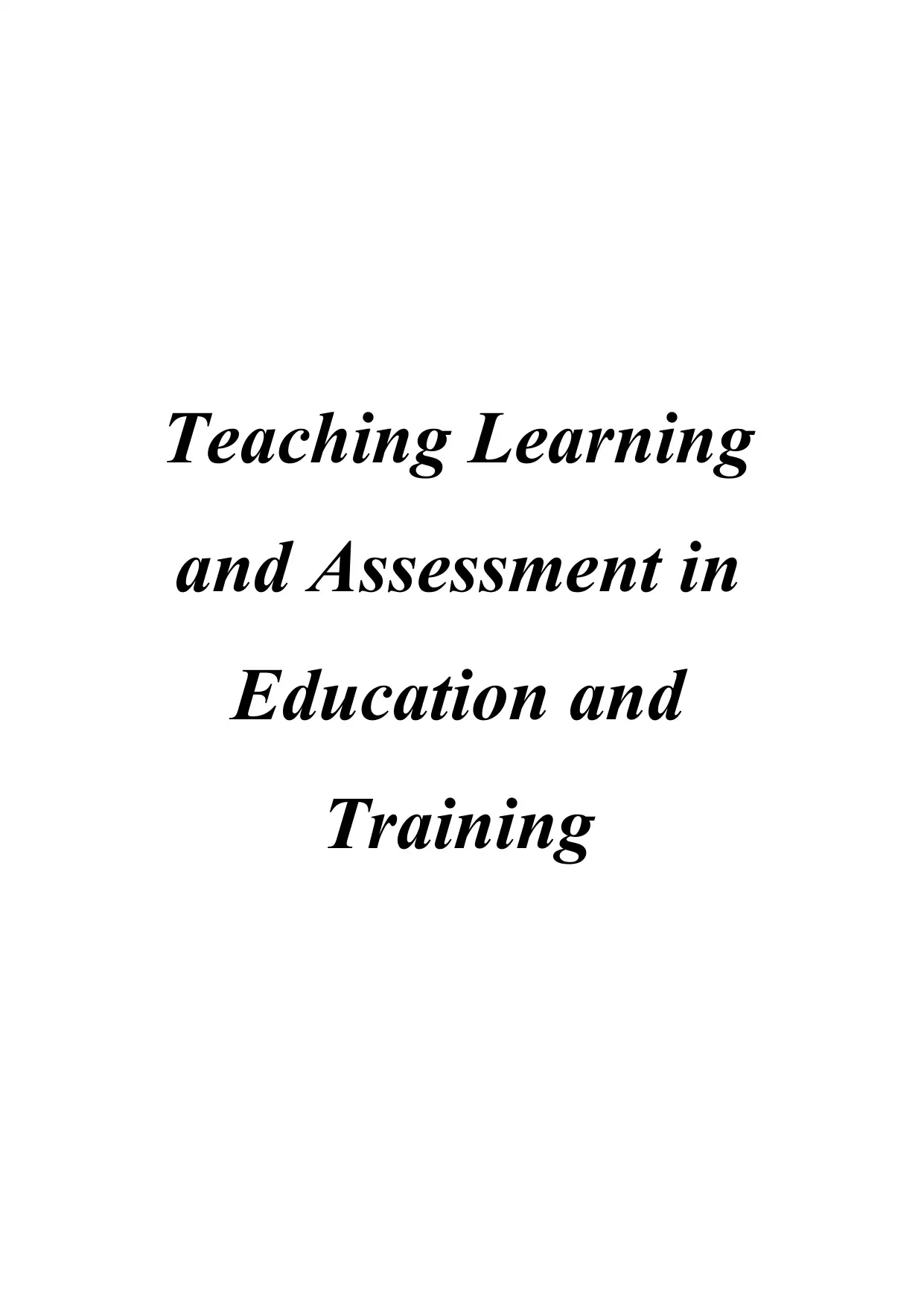
Teaching Learning
and Assessment in
Education and
Training
and Assessment in
Education and
Training
Paraphrase This Document
Need a fresh take? Get an instant paraphrase of this document with our AI Paraphraser

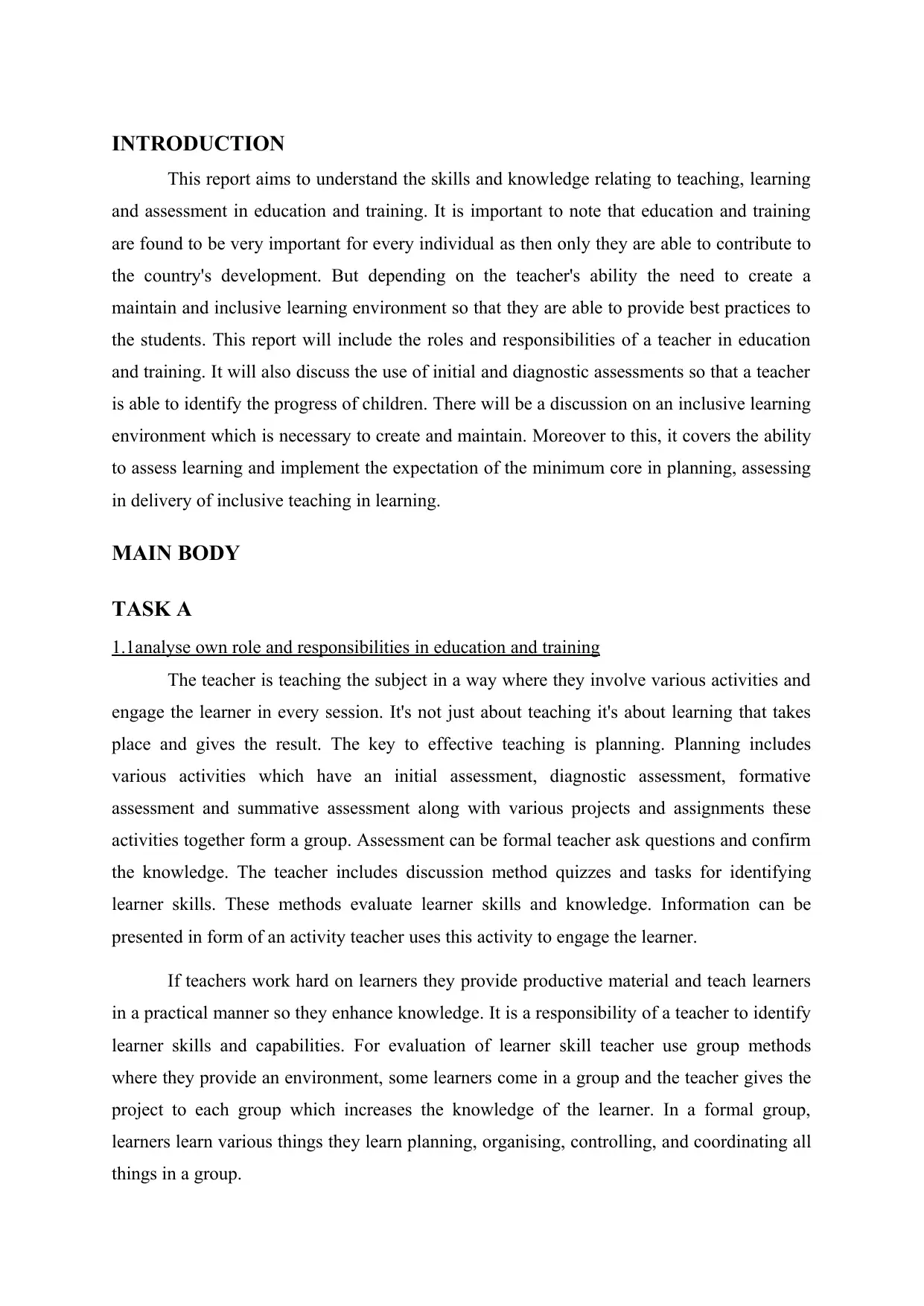
INTRODUCTION
This report aims to understand the skills and knowledge relating to teaching, learning
and assessment in education and training. It is important to note that education and training
are found to be very important for every individual as then only they are able to contribute to
the country's development. But depending on the teacher's ability the need to create a
maintain and inclusive learning environment so that they are able to provide best practices to
the students. This report will include the roles and responsibilities of a teacher in education
and training. It will also discuss the use of initial and diagnostic assessments so that a teacher
is able to identify the progress of children. There will be a discussion on an inclusive learning
environment which is necessary to create and maintain. Moreover to this, it covers the ability
to assess learning and implement the expectation of the minimum core in planning, assessing
in delivery of inclusive teaching in learning.
MAIN BODY
TASK A
1.1analyse own role and responsibilities in education and training
The teacher is teaching the subject in a way where they involve various activities and
engage the learner in every session. It's not just about teaching it's about learning that takes
place and gives the result. The key to effective teaching is planning. Planning includes
various activities which have an initial assessment, diagnostic assessment, formative
assessment and summative assessment along with various projects and assignments these
activities together form a group. Assessment can be formal teacher ask questions and confirm
the knowledge. The teacher includes discussion method quizzes and tasks for identifying
learner skills. These methods evaluate learner skills and knowledge. Information can be
presented in form of an activity teacher uses this activity to engage the learner.
If teachers work hard on learners they provide productive material and teach learners
in a practical manner so they enhance knowledge. It is a responsibility of a teacher to identify
learner skills and capabilities. For evaluation of learner skill teacher use group methods
where they provide an environment, some learners come in a group and the teacher gives the
project to each group which increases the knowledge of the learner. In a formal group,
learners learn various things they learn planning, organising, controlling, and coordinating all
things in a group.
This report aims to understand the skills and knowledge relating to teaching, learning
and assessment in education and training. It is important to note that education and training
are found to be very important for every individual as then only they are able to contribute to
the country's development. But depending on the teacher's ability the need to create a
maintain and inclusive learning environment so that they are able to provide best practices to
the students. This report will include the roles and responsibilities of a teacher in education
and training. It will also discuss the use of initial and diagnostic assessments so that a teacher
is able to identify the progress of children. There will be a discussion on an inclusive learning
environment which is necessary to create and maintain. Moreover to this, it covers the ability
to assess learning and implement the expectation of the minimum core in planning, assessing
in delivery of inclusive teaching in learning.
MAIN BODY
TASK A
1.1analyse own role and responsibilities in education and training
The teacher is teaching the subject in a way where they involve various activities and
engage the learner in every session. It's not just about teaching it's about learning that takes
place and gives the result. The key to effective teaching is planning. Planning includes
various activities which have an initial assessment, diagnostic assessment, formative
assessment and summative assessment along with various projects and assignments these
activities together form a group. Assessment can be formal teacher ask questions and confirm
the knowledge. The teacher includes discussion method quizzes and tasks for identifying
learner skills. These methods evaluate learner skills and knowledge. Information can be
presented in form of an activity teacher uses this activity to engage the learner.
If teachers work hard on learners they provide productive material and teach learners
in a practical manner so they enhance knowledge. It is a responsibility of a teacher to identify
learner skills and capabilities. For evaluation of learner skill teacher use group methods
where they provide an environment, some learners come in a group and the teacher gives the
project to each group which increases the knowledge of the learner. In a formal group,
learners learn various things they learn planning, organising, controlling, and coordinating all
things in a group.
⊘ This is a preview!⊘
Do you want full access?
Subscribe today to unlock all pages.

Trusted by 1+ million students worldwide
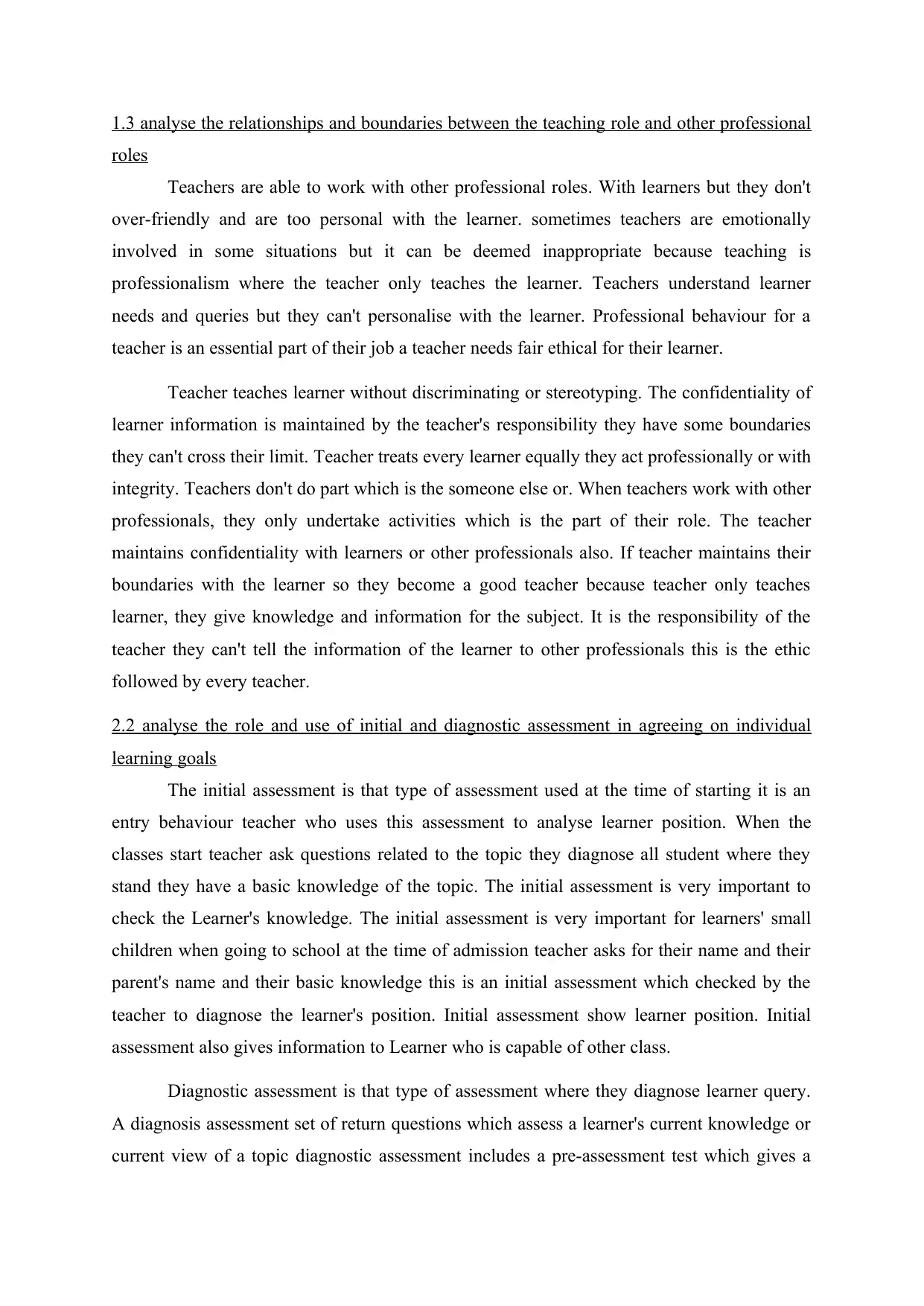
1.3 analyse the relationships and boundaries between the teaching role and other professional
roles
Teachers are able to work with other professional roles. With learners but they don't
over-friendly and are too personal with the learner. sometimes teachers are emotionally
involved in some situations but it can be deemed inappropriate because teaching is
professionalism where the teacher only teaches the learner. Teachers understand learner
needs and queries but they can't personalise with the learner. Professional behaviour for a
teacher is an essential part of their job a teacher needs fair ethical for their learner.
Teacher teaches learner without discriminating or stereotyping. The confidentiality of
learner information is maintained by the teacher's responsibility they have some boundaries
they can't cross their limit. Teacher treats every learner equally they act professionally or with
integrity. Teachers don't do part which is the someone else or. When teachers work with other
professionals, they only undertake activities which is the part of their role. The teacher
maintains confidentiality with learners or other professionals also. If teacher maintains their
boundaries with the learner so they become a good teacher because teacher only teaches
learner, they give knowledge and information for the subject. It is the responsibility of the
teacher they can't tell the information of the learner to other professionals this is the ethic
followed by every teacher.
2.2 analyse the role and use of initial and diagnostic assessment in agreeing on individual
learning goals
The initial assessment is that type of assessment used at the time of starting it is an
entry behaviour teacher who uses this assessment to analyse learner position. When the
classes start teacher ask questions related to the topic they diagnose all student where they
stand they have a basic knowledge of the topic. The initial assessment is very important to
check the Learner's knowledge. The initial assessment is very important for learners' small
children when going to school at the time of admission teacher asks for their name and their
parent's name and their basic knowledge this is an initial assessment which checked by the
teacher to diagnose the learner's position. Initial assessment show learner position. Initial
assessment also gives information to Learner who is capable of other class.
Diagnostic assessment is that type of assessment where they diagnose learner query.
A diagnosis assessment set of return questions which assess a learner's current knowledge or
current view of a topic diagnostic assessment includes a pre-assessment test which gives a
roles
Teachers are able to work with other professional roles. With learners but they don't
over-friendly and are too personal with the learner. sometimes teachers are emotionally
involved in some situations but it can be deemed inappropriate because teaching is
professionalism where the teacher only teaches the learner. Teachers understand learner
needs and queries but they can't personalise with the learner. Professional behaviour for a
teacher is an essential part of their job a teacher needs fair ethical for their learner.
Teacher teaches learner without discriminating or stereotyping. The confidentiality of
learner information is maintained by the teacher's responsibility they have some boundaries
they can't cross their limit. Teacher treats every learner equally they act professionally or with
integrity. Teachers don't do part which is the someone else or. When teachers work with other
professionals, they only undertake activities which is the part of their role. The teacher
maintains confidentiality with learners or other professionals also. If teacher maintains their
boundaries with the learner so they become a good teacher because teacher only teaches
learner, they give knowledge and information for the subject. It is the responsibility of the
teacher they can't tell the information of the learner to other professionals this is the ethic
followed by every teacher.
2.2 analyse the role and use of initial and diagnostic assessment in agreeing on individual
learning goals
The initial assessment is that type of assessment used at the time of starting it is an
entry behaviour teacher who uses this assessment to analyse learner position. When the
classes start teacher ask questions related to the topic they diagnose all student where they
stand they have a basic knowledge of the topic. The initial assessment is very important to
check the Learner's knowledge. The initial assessment is very important for learners' small
children when going to school at the time of admission teacher asks for their name and their
parent's name and their basic knowledge this is an initial assessment which checked by the
teacher to diagnose the learner's position. Initial assessment show learner position. Initial
assessment also gives information to Learner who is capable of other class.
Diagnostic assessment is that type of assessment where they diagnose learner query.
A diagnosis assessment set of return questions which assess a learner's current knowledge or
current view of a topic diagnostic assessment includes a pre-assessment test which gives a
Paraphrase This Document
Need a fresh take? Get an instant paraphrase of this document with our AI Paraphraser
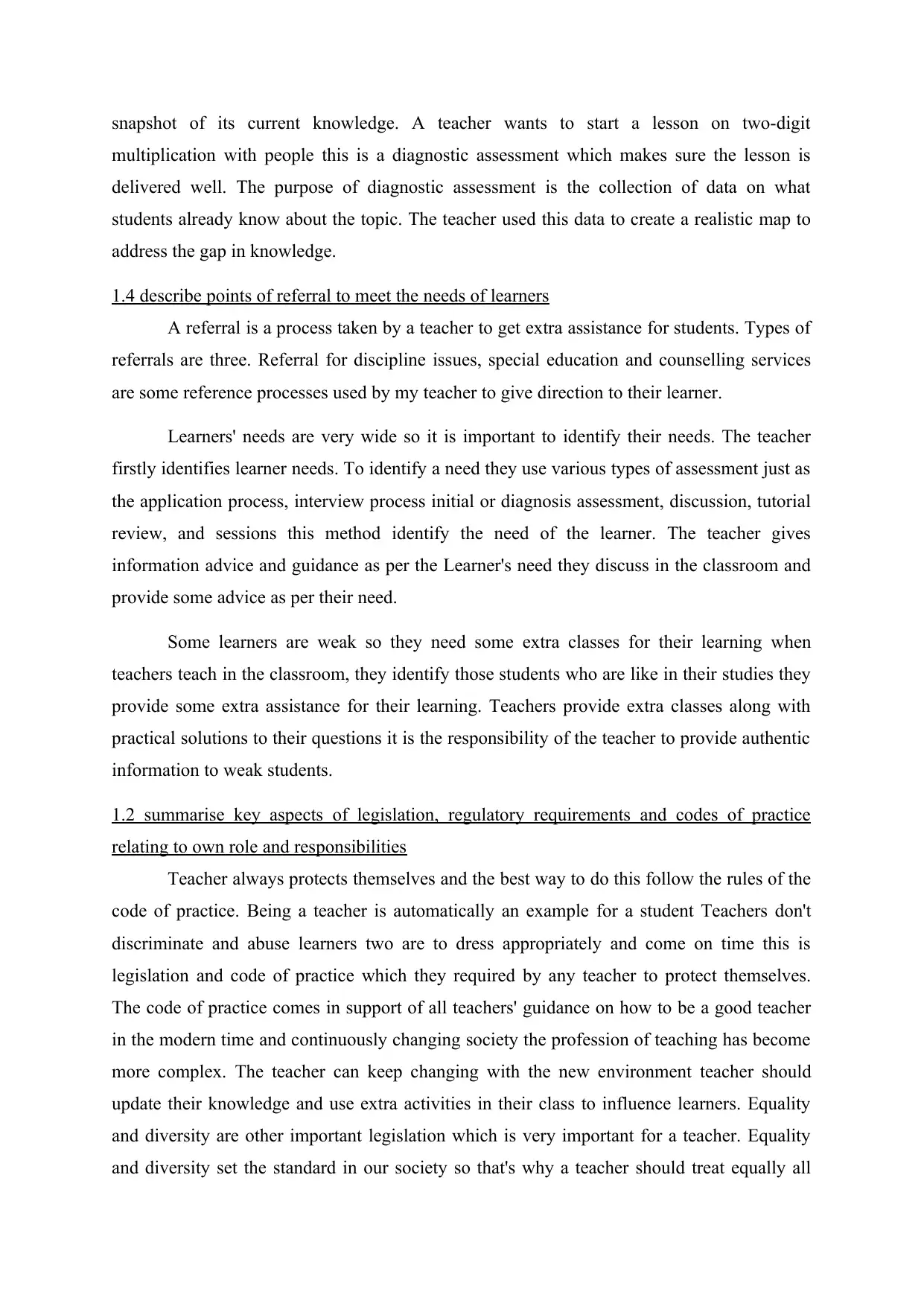
snapshot of its current knowledge. A teacher wants to start a lesson on two-digit
multiplication with people this is a diagnostic assessment which makes sure the lesson is
delivered well. The purpose of diagnostic assessment is the collection of data on what
students already know about the topic. The teacher used this data to create a realistic map to
address the gap in knowledge.
1.4 describe points of referral to meet the needs of learners
A referral is a process taken by a teacher to get extra assistance for students. Types of
referrals are three. Referral for discipline issues, special education and counselling services
are some reference processes used by my teacher to give direction to their learner.
Learners' needs are very wide so it is important to identify their needs. The teacher
firstly identifies learner needs. To identify a need they use various types of assessment just as
the application process, interview process initial or diagnosis assessment, discussion, tutorial
review, and sessions this method identify the need of the learner. The teacher gives
information advice and guidance as per the Learner's need they discuss in the classroom and
provide some advice as per their need.
Some learners are weak so they need some extra classes for their learning when
teachers teach in the classroom, they identify those students who are like in their studies they
provide some extra assistance for their learning. Teachers provide extra classes along with
practical solutions to their questions it is the responsibility of the teacher to provide authentic
information to weak students.
1.2 summarise key aspects of legislation, regulatory requirements and codes of practice
relating to own role and responsibilities
Teacher always protects themselves and the best way to do this follow the rules of the
code of practice. Being a teacher is automatically an example for a student Teachers don't
discriminate and abuse learners two are to dress appropriately and come on time this is
legislation and code of practice which they required by any teacher to protect themselves.
The code of practice comes in support of all teachers' guidance on how to be a good teacher
in the modern time and continuously changing society the profession of teaching has become
more complex. The teacher can keep changing with the new environment teacher should
update their knowledge and use extra activities in their class to influence learners. Equality
and diversity are other important legislation which is very important for a teacher. Equality
and diversity set the standard in our society so that's why a teacher should treat equally all
multiplication with people this is a diagnostic assessment which makes sure the lesson is
delivered well. The purpose of diagnostic assessment is the collection of data on what
students already know about the topic. The teacher used this data to create a realistic map to
address the gap in knowledge.
1.4 describe points of referral to meet the needs of learners
A referral is a process taken by a teacher to get extra assistance for students. Types of
referrals are three. Referral for discipline issues, special education and counselling services
are some reference processes used by my teacher to give direction to their learner.
Learners' needs are very wide so it is important to identify their needs. The teacher
firstly identifies learner needs. To identify a need they use various types of assessment just as
the application process, interview process initial or diagnosis assessment, discussion, tutorial
review, and sessions this method identify the need of the learner. The teacher gives
information advice and guidance as per the Learner's need they discuss in the classroom and
provide some advice as per their need.
Some learners are weak so they need some extra classes for their learning when
teachers teach in the classroom, they identify those students who are like in their studies they
provide some extra assistance for their learning. Teachers provide extra classes along with
practical solutions to their questions it is the responsibility of the teacher to provide authentic
information to weak students.
1.2 summarise key aspects of legislation, regulatory requirements and codes of practice
relating to own role and responsibilities
Teacher always protects themselves and the best way to do this follow the rules of the
code of practice. Being a teacher is automatically an example for a student Teachers don't
discriminate and abuse learners two are to dress appropriately and come on time this is
legislation and code of practice which they required by any teacher to protect themselves.
The code of practice comes in support of all teachers' guidance on how to be a good teacher
in the modern time and continuously changing society the profession of teaching has become
more complex. The teacher can keep changing with the new environment teacher should
update their knowledge and use extra activities in their class to influence learners. Equality
and diversity are other important legislation which is very important for a teacher. Equality
and diversity set the standard in our society so that's why a teacher should treat equally all
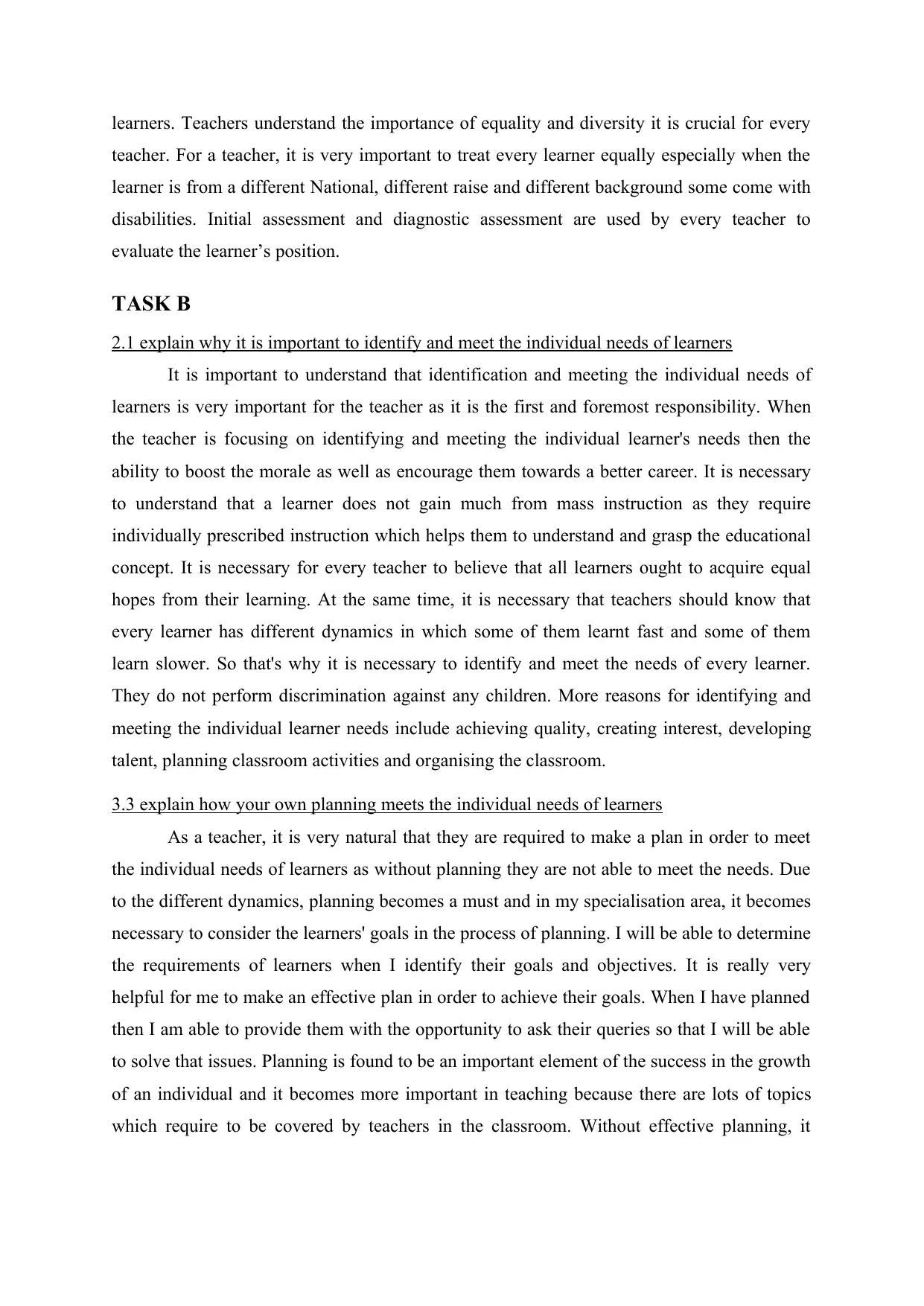
learners. Teachers understand the importance of equality and diversity it is crucial for every
teacher. For a teacher, it is very important to treat every learner equally especially when the
learner is from a different National, different raise and different background some come with
disabilities. Initial assessment and diagnostic assessment are used by every teacher to
evaluate the learner’s position.
TASK B
2.1 explain why it is important to identify and meet the individual needs of learners
It is important to understand that identification and meeting the individual needs of
learners is very important for the teacher as it is the first and foremost responsibility. When
the teacher is focusing on identifying and meeting the individual learner's needs then the
ability to boost the morale as well as encourage them towards a better career. It is necessary
to understand that a learner does not gain much from mass instruction as they require
individually prescribed instruction which helps them to understand and grasp the educational
concept. It is necessary for every teacher to believe that all learners ought to acquire equal
hopes from their learning. At the same time, it is necessary that teachers should know that
every learner has different dynamics in which some of them learnt fast and some of them
learn slower. So that's why it is necessary to identify and meet the needs of every learner.
They do not perform discrimination against any children. More reasons for identifying and
meeting the individual learner needs include achieving quality, creating interest, developing
talent, planning classroom activities and organising the classroom.
3.3 explain how your own planning meets the individual needs of learners
As a teacher, it is very natural that they are required to make a plan in order to meet
the individual needs of learners as without planning they are not able to meet the needs. Due
to the different dynamics, planning becomes a must and in my specialisation area, it becomes
necessary to consider the learners' goals in the process of planning. I will be able to determine
the requirements of learners when I identify their goals and objectives. It is really very
helpful for me to make an effective plan in order to achieve their goals. When I have planned
then I am able to provide them with the opportunity to ask their queries so that I will be able
to solve that issues. Planning is found to be an important element of the success in the growth
of an individual and it becomes more important in teaching because there are lots of topics
which require to be covered by teachers in the classroom. Without effective planning, it
teacher. For a teacher, it is very important to treat every learner equally especially when the
learner is from a different National, different raise and different background some come with
disabilities. Initial assessment and diagnostic assessment are used by every teacher to
evaluate the learner’s position.
TASK B
2.1 explain why it is important to identify and meet the individual needs of learners
It is important to understand that identification and meeting the individual needs of
learners is very important for the teacher as it is the first and foremost responsibility. When
the teacher is focusing on identifying and meeting the individual learner's needs then the
ability to boost the morale as well as encourage them towards a better career. It is necessary
to understand that a learner does not gain much from mass instruction as they require
individually prescribed instruction which helps them to understand and grasp the educational
concept. It is necessary for every teacher to believe that all learners ought to acquire equal
hopes from their learning. At the same time, it is necessary that teachers should know that
every learner has different dynamics in which some of them learnt fast and some of them
learn slower. So that's why it is necessary to identify and meet the needs of every learner.
They do not perform discrimination against any children. More reasons for identifying and
meeting the individual learner needs include achieving quality, creating interest, developing
talent, planning classroom activities and organising the classroom.
3.3 explain how your own planning meets the individual needs of learners
As a teacher, it is very natural that they are required to make a plan in order to meet
the individual needs of learners as without planning they are not able to meet the needs. Due
to the different dynamics, planning becomes a must and in my specialisation area, it becomes
necessary to consider the learners' goals in the process of planning. I will be able to determine
the requirements of learners when I identify their goals and objectives. It is really very
helpful for me to make an effective plan in order to achieve their goals. When I have planned
then I am able to provide them with the opportunity to ask their queries so that I will be able
to solve that issues. Planning is found to be an important element of the success in the growth
of an individual and it becomes more important in teaching because there are lots of topics
which require to be covered by teachers in the classroom. Without effective planning, it
⊘ This is a preview!⊘
Do you want full access?
Subscribe today to unlock all pages.

Trusted by 1+ million students worldwide
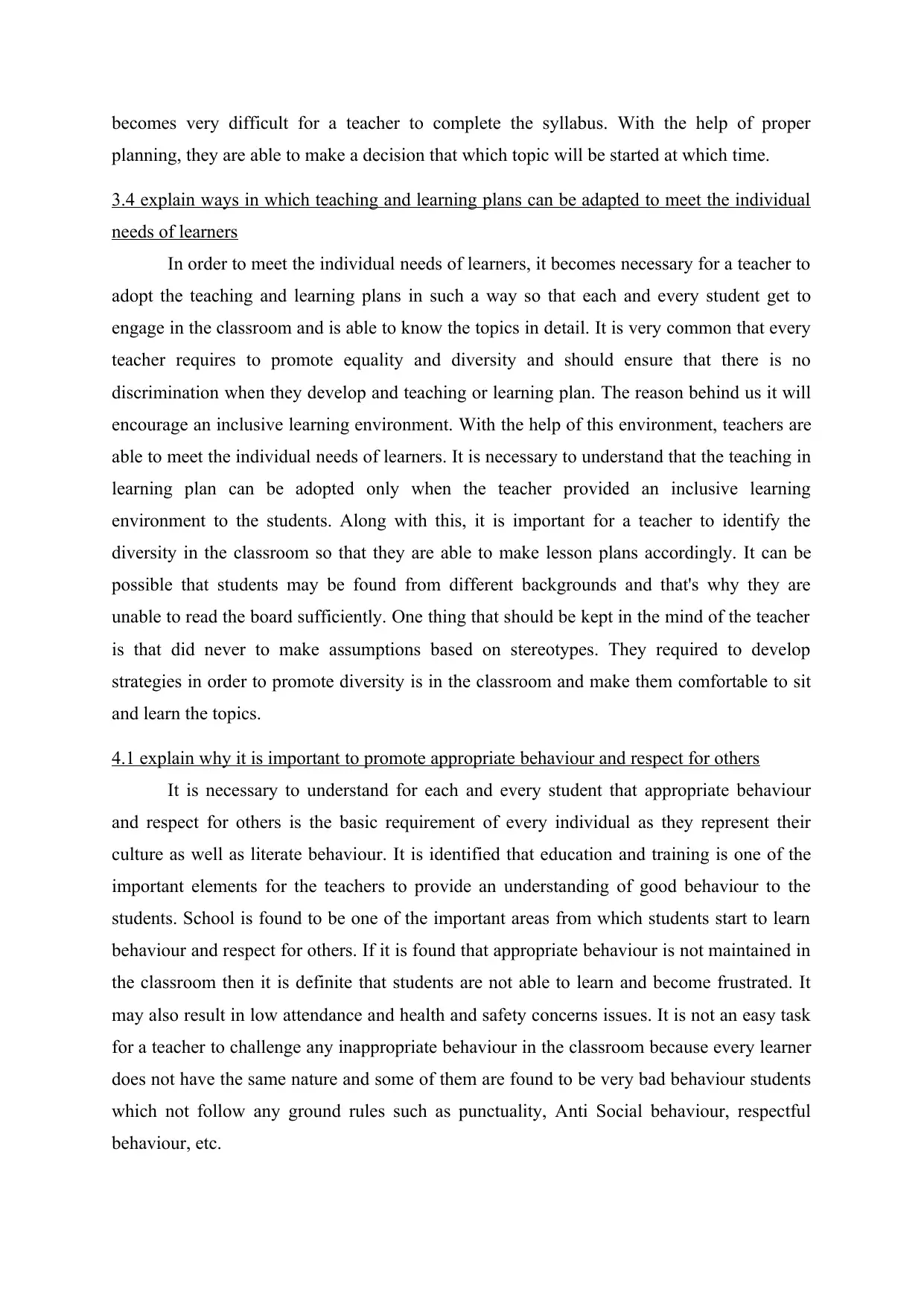
becomes very difficult for a teacher to complete the syllabus. With the help of proper
planning, they are able to make a decision that which topic will be started at which time.
3.4 explain ways in which teaching and learning plans can be adapted to meet the individual
needs of learners
In order to meet the individual needs of learners, it becomes necessary for a teacher to
adopt the teaching and learning plans in such a way so that each and every student get to
engage in the classroom and is able to know the topics in detail. It is very common that every
teacher requires to promote equality and diversity and should ensure that there is no
discrimination when they develop and teaching or learning plan. The reason behind us it will
encourage an inclusive learning environment. With the help of this environment, teachers are
able to meet the individual needs of learners. It is necessary to understand that the teaching in
learning plan can be adopted only when the teacher provided an inclusive learning
environment to the students. Along with this, it is important for a teacher to identify the
diversity in the classroom so that they are able to make lesson plans accordingly. It can be
possible that students may be found from different backgrounds and that's why they are
unable to read the board sufficiently. One thing that should be kept in the mind of the teacher
is that did never to make assumptions based on stereotypes. They required to develop
strategies in order to promote diversity is in the classroom and make them comfortable to sit
and learn the topics.
4.1 explain why it is important to promote appropriate behaviour and respect for others
It is necessary to understand for each and every student that appropriate behaviour
and respect for others is the basic requirement of every individual as they represent their
culture as well as literate behaviour. It is identified that education and training is one of the
important elements for the teachers to provide an understanding of good behaviour to the
students. School is found to be one of the important areas from which students start to learn
behaviour and respect for others. If it is found that appropriate behaviour is not maintained in
the classroom then it is definite that students are not able to learn and become frustrated. It
may also result in low attendance and health and safety concerns issues. It is not an easy task
for a teacher to challenge any inappropriate behaviour in the classroom because every learner
does not have the same nature and some of them are found to be very bad behaviour students
which not follow any ground rules such as punctuality, Anti Social behaviour, respectful
behaviour, etc.
planning, they are able to make a decision that which topic will be started at which time.
3.4 explain ways in which teaching and learning plans can be adapted to meet the individual
needs of learners
In order to meet the individual needs of learners, it becomes necessary for a teacher to
adopt the teaching and learning plans in such a way so that each and every student get to
engage in the classroom and is able to know the topics in detail. It is very common that every
teacher requires to promote equality and diversity and should ensure that there is no
discrimination when they develop and teaching or learning plan. The reason behind us it will
encourage an inclusive learning environment. With the help of this environment, teachers are
able to meet the individual needs of learners. It is necessary to understand that the teaching in
learning plan can be adopted only when the teacher provided an inclusive learning
environment to the students. Along with this, it is important for a teacher to identify the
diversity in the classroom so that they are able to make lesson plans accordingly. It can be
possible that students may be found from different backgrounds and that's why they are
unable to read the board sufficiently. One thing that should be kept in the mind of the teacher
is that did never to make assumptions based on stereotypes. They required to develop
strategies in order to promote diversity is in the classroom and make them comfortable to sit
and learn the topics.
4.1 explain why it is important to promote appropriate behaviour and respect for others
It is necessary to understand for each and every student that appropriate behaviour
and respect for others is the basic requirement of every individual as they represent their
culture as well as literate behaviour. It is identified that education and training is one of the
important elements for the teachers to provide an understanding of good behaviour to the
students. School is found to be one of the important areas from which students start to learn
behaviour and respect for others. If it is found that appropriate behaviour is not maintained in
the classroom then it is definite that students are not able to learn and become frustrated. It
may also result in low attendance and health and safety concerns issues. It is not an easy task
for a teacher to challenge any inappropriate behaviour in the classroom because every learner
does not have the same nature and some of them are found to be very bad behaviour students
which not follow any ground rules such as punctuality, Anti Social behaviour, respectful
behaviour, etc.
Paraphrase This Document
Need a fresh take? Get an instant paraphrase of this document with our AI Paraphraser
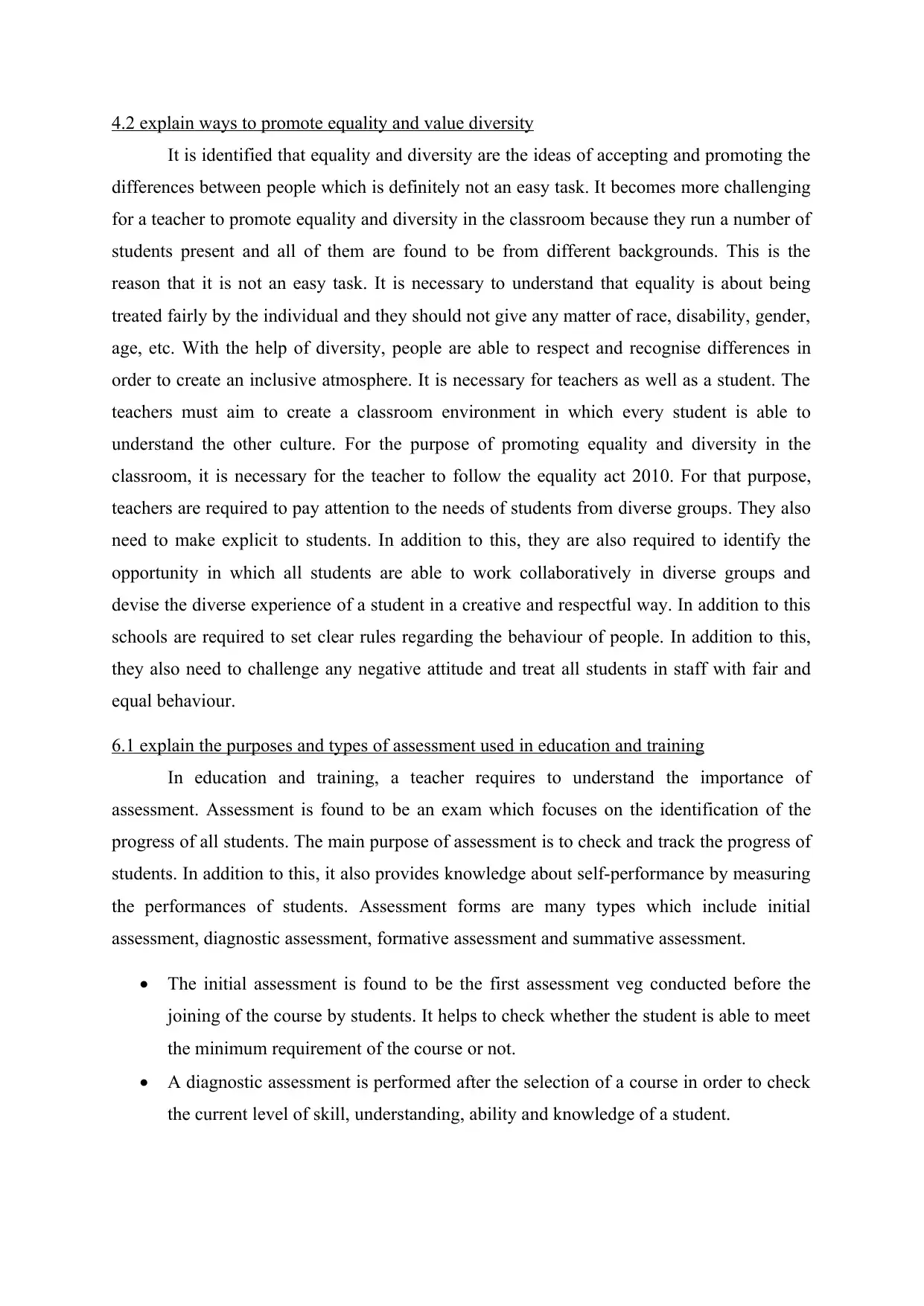
4.2 explain ways to promote equality and value diversity
It is identified that equality and diversity are the ideas of accepting and promoting the
differences between people which is definitely not an easy task. It becomes more challenging
for a teacher to promote equality and diversity in the classroom because they run a number of
students present and all of them are found to be from different backgrounds. This is the
reason that it is not an easy task. It is necessary to understand that equality is about being
treated fairly by the individual and they should not give any matter of race, disability, gender,
age, etc. With the help of diversity, people are able to respect and recognise differences in
order to create an inclusive atmosphere. It is necessary for teachers as well as a student. The
teachers must aim to create a classroom environment in which every student is able to
understand the other culture. For the purpose of promoting equality and diversity in the
classroom, it is necessary for the teacher to follow the equality act 2010. For that purpose,
teachers are required to pay attention to the needs of students from diverse groups. They also
need to make explicit to students. In addition to this, they are also required to identify the
opportunity in which all students are able to work collaboratively in diverse groups and
devise the diverse experience of a student in a creative and respectful way. In addition to this
schools are required to set clear rules regarding the behaviour of people. In addition to this,
they also need to challenge any negative attitude and treat all students in staff with fair and
equal behaviour.
6.1 explain the purposes and types of assessment used in education and training
In education and training, a teacher requires to understand the importance of
assessment. Assessment is found to be an exam which focuses on the identification of the
progress of all students. The main purpose of assessment is to check and track the progress of
students. In addition to this, it also provides knowledge about self-performance by measuring
the performances of students. Assessment forms are many types which include initial
assessment, diagnostic assessment, formative assessment and summative assessment.
The initial assessment is found to be the first assessment veg conducted before the
joining of the course by students. It helps to check whether the student is able to meet
the minimum requirement of the course or not.
A diagnostic assessment is performed after the selection of a course in order to check
the current level of skill, understanding, ability and knowledge of a student.
It is identified that equality and diversity are the ideas of accepting and promoting the
differences between people which is definitely not an easy task. It becomes more challenging
for a teacher to promote equality and diversity in the classroom because they run a number of
students present and all of them are found to be from different backgrounds. This is the
reason that it is not an easy task. It is necessary to understand that equality is about being
treated fairly by the individual and they should not give any matter of race, disability, gender,
age, etc. With the help of diversity, people are able to respect and recognise differences in
order to create an inclusive atmosphere. It is necessary for teachers as well as a student. The
teachers must aim to create a classroom environment in which every student is able to
understand the other culture. For the purpose of promoting equality and diversity in the
classroom, it is necessary for the teacher to follow the equality act 2010. For that purpose,
teachers are required to pay attention to the needs of students from diverse groups. They also
need to make explicit to students. In addition to this, they are also required to identify the
opportunity in which all students are able to work collaboratively in diverse groups and
devise the diverse experience of a student in a creative and respectful way. In addition to this
schools are required to set clear rules regarding the behaviour of people. In addition to this,
they also need to challenge any negative attitude and treat all students in staff with fair and
equal behaviour.
6.1 explain the purposes and types of assessment used in education and training
In education and training, a teacher requires to understand the importance of
assessment. Assessment is found to be an exam which focuses on the identification of the
progress of all students. The main purpose of assessment is to check and track the progress of
students. In addition to this, it also provides knowledge about self-performance by measuring
the performances of students. Assessment forms are many types which include initial
assessment, diagnostic assessment, formative assessment and summative assessment.
The initial assessment is found to be the first assessment veg conducted before the
joining of the course by students. It helps to check whether the student is able to meet
the minimum requirement of the course or not.
A diagnostic assessment is performed after the selection of a course in order to check
the current level of skill, understanding, ability and knowledge of a student.
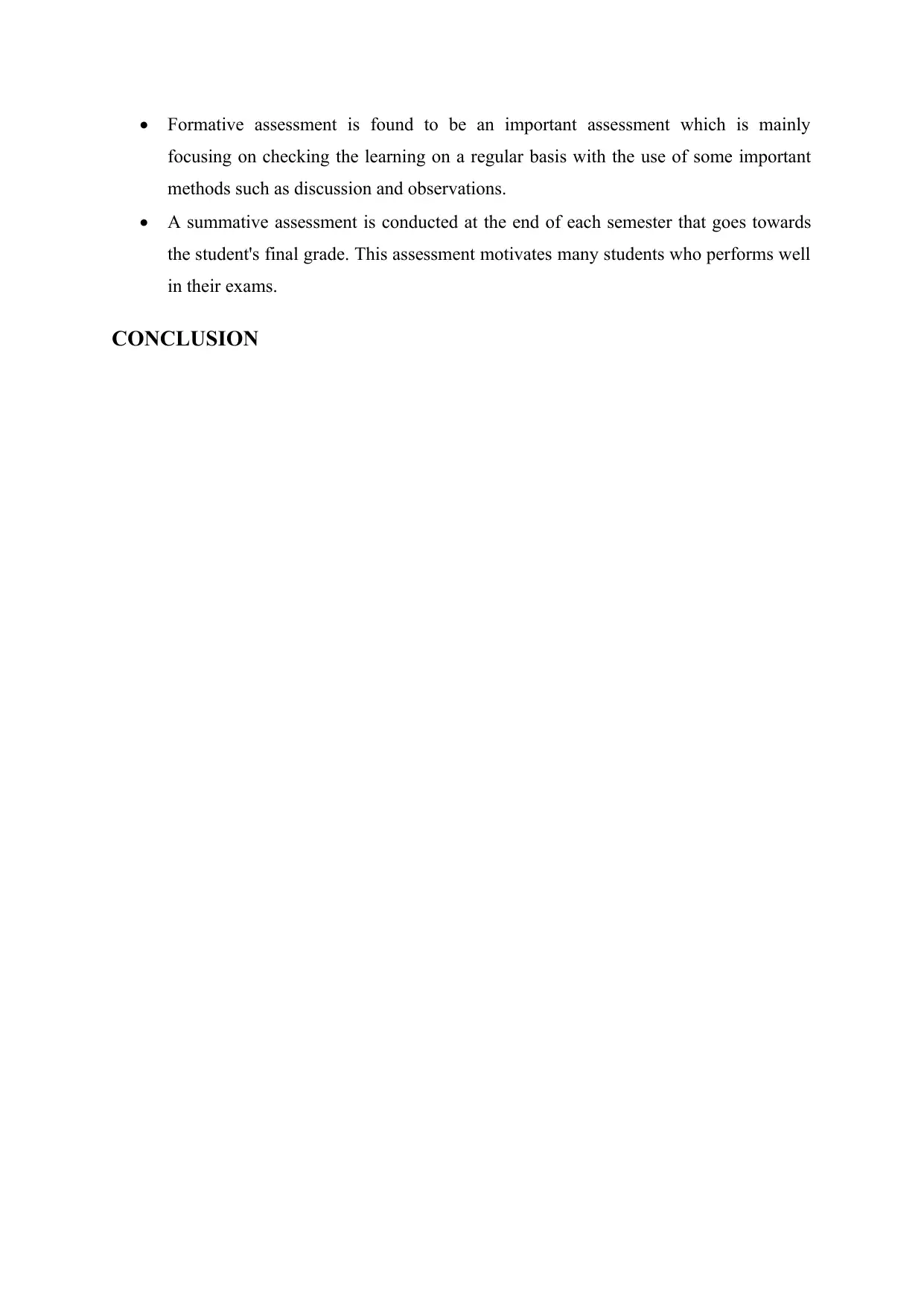
Formative assessment is found to be an important assessment which is mainly
focusing on checking the learning on a regular basis with the use of some important
methods such as discussion and observations.
A summative assessment is conducted at the end of each semester that goes towards
the student's final grade. This assessment motivates many students who performs well
in their exams.
CONCLUSION
focusing on checking the learning on a regular basis with the use of some important
methods such as discussion and observations.
A summative assessment is conducted at the end of each semester that goes towards
the student's final grade. This assessment motivates many students who performs well
in their exams.
CONCLUSION
⊘ This is a preview!⊘
Do you want full access?
Subscribe today to unlock all pages.

Trusted by 1+ million students worldwide
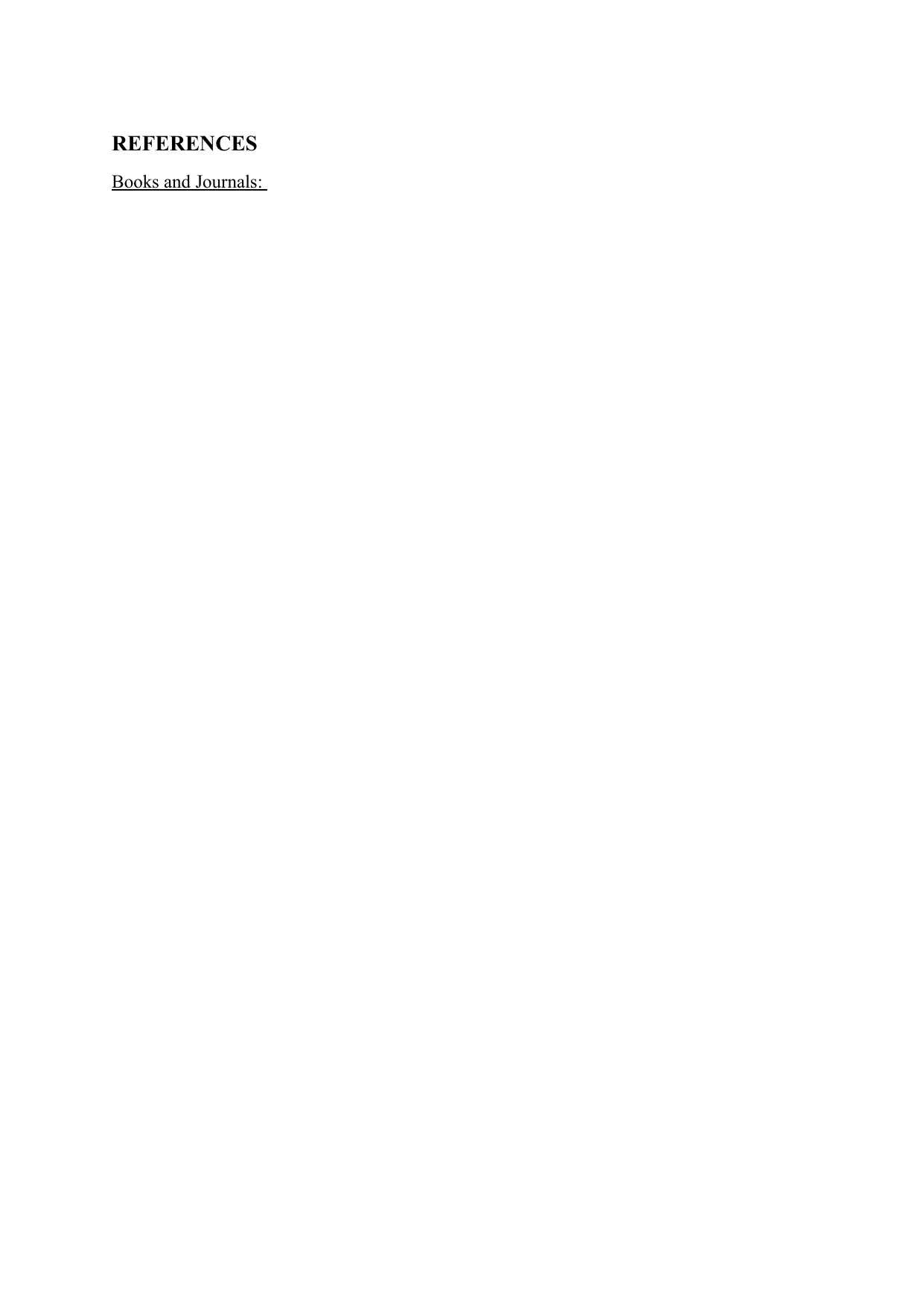
REFERENCES
Books and Journals:
Books and Journals:
1 out of 10
Related Documents
Your All-in-One AI-Powered Toolkit for Academic Success.
+13062052269
info@desklib.com
Available 24*7 on WhatsApp / Email
![[object Object]](/_next/static/media/star-bottom.7253800d.svg)
Unlock your academic potential
Copyright © 2020–2025 A2Z Services. All Rights Reserved. Developed and managed by ZUCOL.



